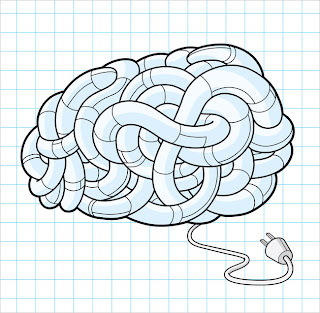This blog post was inspired by a New York Times book review that I came across several weeks ago. The review was of Kevin Kelly's newest work entitled What Technology Wants, and which discusses our relationship with and dependence on technology as not only beneficial, but also inevitable (“…the eventual appearance of the BlackBerry was imminent in the Big Bang”). While the book focuses more on the evolution of human society based on our use of technology, it did get me thinking more about our relationship with technology within, as Latour might say, the modern collective.
What does technology want? Or better yet, how does technology want? This latter question came up quite recently, at a seminar I attended during which we encountered some technical difficulties with the slide projector. I realized, watching the attendees of the conference try, one-by-one in vain, to fix the projector (eventually a different one had to be called in), that it is in these moments, when technology fails us, that we might be able to better understand our relationship with it.

In terms or Peircean semiotics, when technology doesn’t work, it can be considered "secondness" in that it is in those instances that technology forces us to confront it, to acknowledge it, and to adjust our lives according to it (think of all of the times you’ve had to change your routes because the subway was not running properly…). This got me thinking about the ways in which humans and technology have become hybridized in the modern world. How does technology act upon us? What kind of agency does it have? I already brought up the example that when technology breaks down, it has the potential to ruin our day, to mess up our schedules, and in many ways, to render our intentions and actions completely useless.
In this way then, we can think of our relationship on technology as one, sadly, of dependency, and we have in many ways already become human-technological hybrids. Our behavior in the modern world, checking email, communicating with friends and colleagues half a world away, turning on lights, blogging, etc… is all dependent on our creation of the technological means by which we do these things; without them, we could not behave in the same way, though without us, they (technology) would not have been created. It is thus a mutual dependency that sustains us both, and in the absence of human-technology hybrid agency, the modern world probably would not be able to function as it currently does.

Some questions that this brief thought experiment raises:
- Is human-technological hybridization a bad thing? Is it dangerous? Are we in danger of taking it too far?
- Has technology truly improved our lives? Has it improved humanity?
- Can we trace back to the beginnings of human-technological hybridization? Where would we delineate the boundaries of what “technology” is?
- Is there potential for the creation of a whole different evolutionary history that can be examined when we think not of “humans” but of “human-technological hybrids”?
2 comments:
Your post raises some interesting and essential questions. One thing that struck me, in relation to this week's reading, was your elucidation of that point at which we recognize our dependancy on technology: when it breaks down. This is akin to what Connerton describes in "How Societies Remember" as the only point at which we really take stock of our habitual behaviors: when we err in some way. Only then do these embodied practices make themselves evident.
-Matthew
I was planning on posting about a similar topic, and instead decided to post it as a comment. Instead of focusing on the break down of technology, what about embracing technology. Specifically, digital technology. And, specifically among academics and scholars, a group usually considered technology challenged. In a recent NY Times article, the author states that members of a new generation of digitally savvy humanists argue it is time to stop looking for inspiration in the next political or philosophical “ism” and start exploring how technology is changing our understanding of the liberal arts. For example, many researchers are now able to digitally map sites. This allows researchers to coordinate work, especially on projects where the amount of material is too much for one person to digest and could never be accurately portrayed by older methods. It also allows for a level of interaction, never possible before. For example the virtual tour of the Lascaux cave (http://www.lascaux.culture.fr/index.php#/fr/02_00.xml), which lets you walk through the complex set of caves, which contain some of the best known examples of Upper Paleolithic art. Similar projects have been done on historically archaeology projects, such as civil war sites, as well as projects pertaining to medieval history, and Renaissance art, just to site a few of the broad examples.
Cite: Digital Keys for Unlocking the Humanities’ Riches (http://www.nytimes.com/2010/11/17/arts/17digital.html?pagewanted=2&_r=1&sq=new%20technologies%20in%20humanities&st=cse&scp=1)
Post a Comment